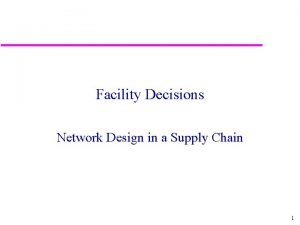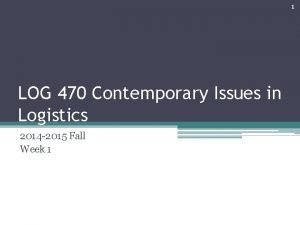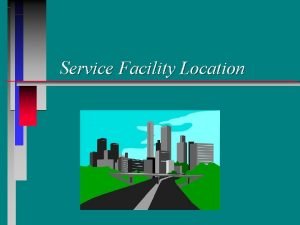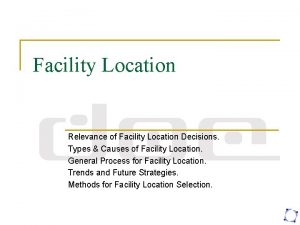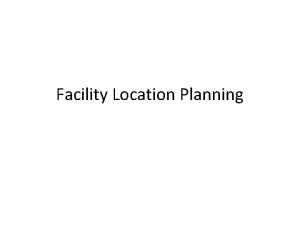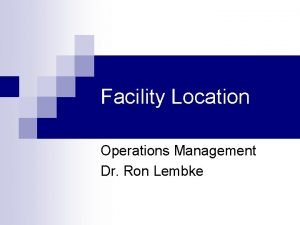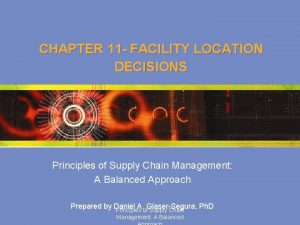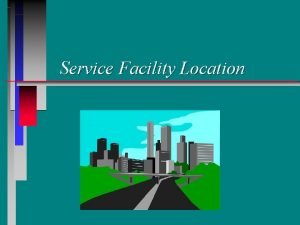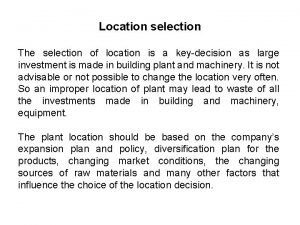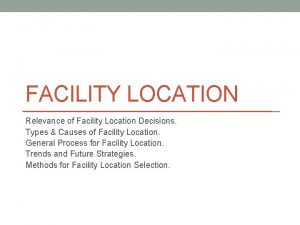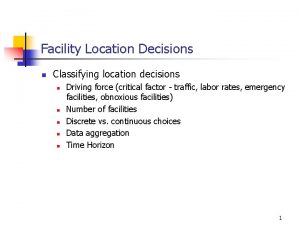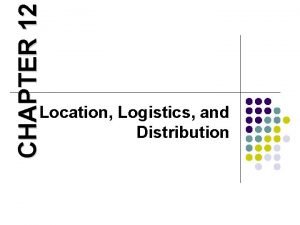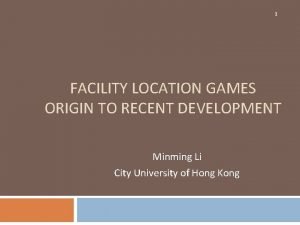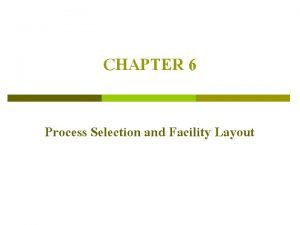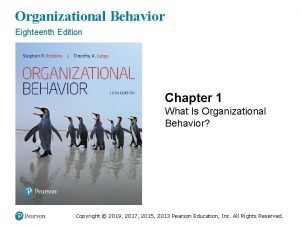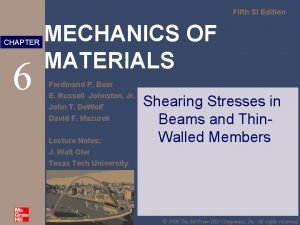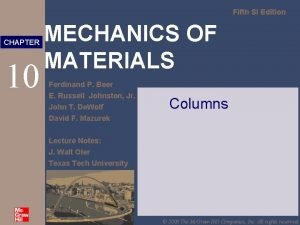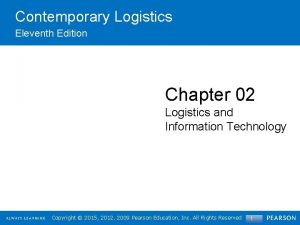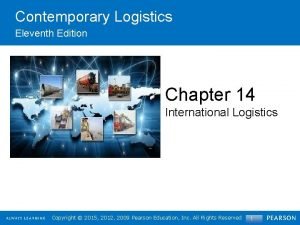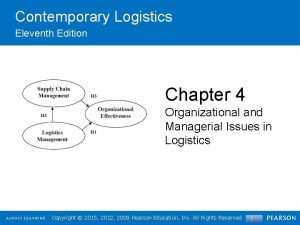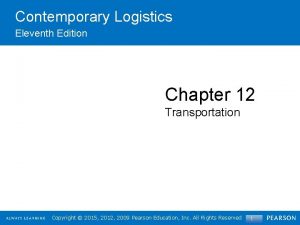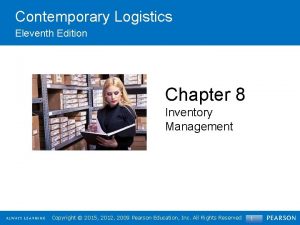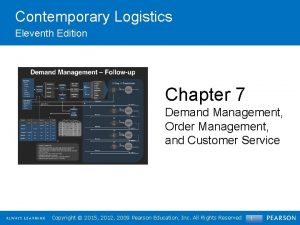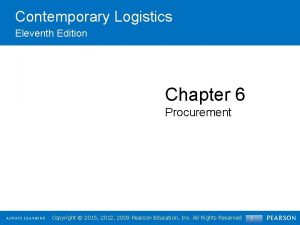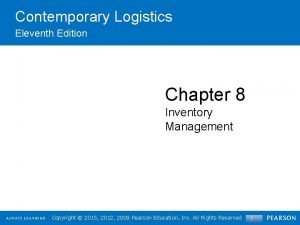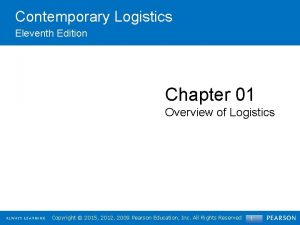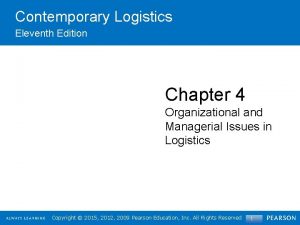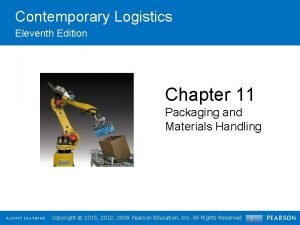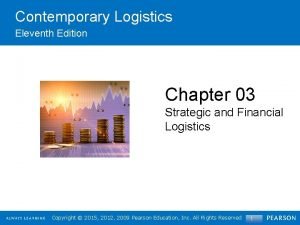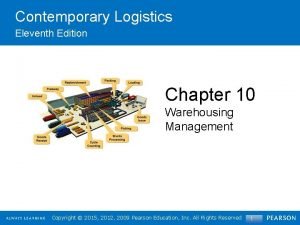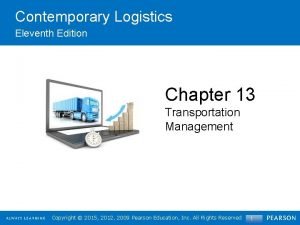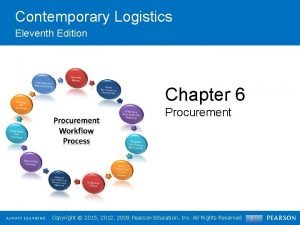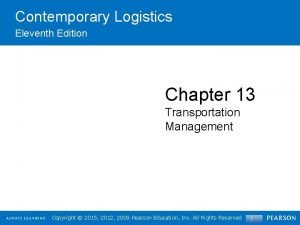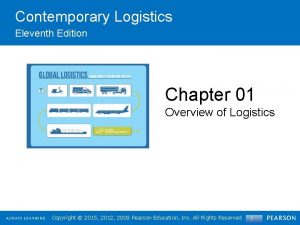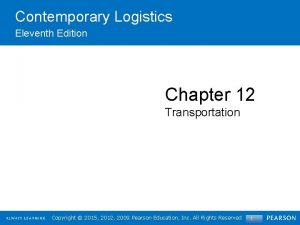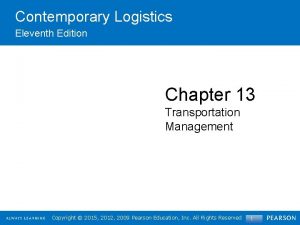Contemporary Logistics Eleventh Edition Chapter 09 Facility Location






































- Slides: 38

Contemporary Logistics Eleventh Edition Chapter 09 Facility Location Copyright©© 2015, 2012, 2009 Pearson. Education, Inc. All. Rights. Reserved Copyright 1

Learning Objectives • To examine the strategic importance of facility location • To explain the general process of determining the optimum number of facilities • To describe the major factors that influence facility location • To examine a site’s specialized location characteristics • To explain location decisions using simple grid systems • To learn about facility relocation and facility closing Copyright © 2015, 2012, 2009 Pearson Education, Inc. All Rights Reserved 2

Facility Location Key Terms (1 of 3) • Agglomeration (industry cluster) • Brownfields • Center-of-gravity approach • Expatriate workers • Facility closing • Facility location • Facility relocation • Free trade zone Copyright © 2015, 2012, 2009 Pearson Education, Inc. All Rights Reserved 3

Facility Location Key Terms (2 of 3) • Grid system • Intermodal competition • Intramodal competition • Inventory tax • Locavore strategy • Maquiladora • Pure materials • Quality-of-life considerations Copyright © 2015, 2012, 2009 Pearson Education, Inc. All Rights Reserved 4

Facility Location Key Terms (3 of 3) • Right-to-work laws • Supplier parks • Sweatshops • Weight-gaining products • Weight-losing products Copyright © 2015, 2012, 2009 Pearson Education, Inc. All Rights Reserved 5

Facility Location • Facility location • refers to choosing the locations for distribution centers, warehouses, and production facilities to facilitate logistical effectiveness and efficiency Copyright © 2015, 2012, 2009 Pearson Education, Inc. All Rights Reserved 6

The Strategic Importance of Facility Location (1 of 4) • Factors that can influence facility location decisions include: • Cost considerations • Consumers sensitized to buy only when prices are low • Low price/low cost framework led companies to operate in countries with low-cost labor • Companies reconsidering locations due to significant surge in oil prices (adopting nearsourcing) Copyright © 2015, 2012, 2009 Pearson Education, Inc. All Rights Reserved 7

The Strategic Importance of Facility Location (2 of 4) • Factors that can influence facility location decisions include: • Customer service expectations • Expectations continue to increase over time • Customers looking for faster and more reliable order cycles Copyright © 2015, 2012, 2009 Pearson Education, Inc. All Rights Reserved 8

The Strategic Importance of Facility Location (3 of 4) • Factors that can influence facility location decisions include: • Location of Customer or Supply Markets • Population shift • Economics growth • Sustainability Copyright © 2015, 2012, 2009 Pearson Education, Inc. All Rights Reserved 9

The Strategic Importance of Facility Location (4 of 4) TABLE 9. 1 Five Most Populous States in the United States 1950, 1980, and 2010 Rank 1950 1980 2010 1 New York California 2 California New York Texas 3 Pennsylvania Texas New York 4 Illinois Pennsylvania Florida 5 Ohio Illinois Source: Derived from data www. census. gov. Copyright © 2015, 2012, 2009 Pearson Education, Inc. All Rights Reserved 10

Determining the Number of Facilities • Facilities are generally added when service levels become unacceptable • Software packages exist to help in determining the number and location of facilities • Key issue—time it takes to get from facility to majority of the U. S. (or target) population • Moving from 2 to 5 facilities saves 1 day lead time • Moving from 5 to 10 facilities saves ½ day lead time • Source: www. chicago-consulting. com Copyright © 2015, 2012, 2009 Pearson Education, Inc. All Rights Reserved 11

General Factors Influencing Facility Location (1 of 10) • Influences on location of manufacturing, processing, or assembly facility • Raw materials • Component parts • Labor • Markets • Warehouses, distribution centers, and cross-docking facilities locations influenced by locations of products they handle and markets served Copyright © 2015, 2012, 2009 Pearson Education, Inc. All Rights Reserved 12

General Factors Influencing Facility Location (2 of 10) FIGURE 9. 1 Chicago Consulting’s 10 Best Chinese Warehouse Networks The 10 best Chinese warehouse networks Network with the lowest possible "time to the Chinese population" Average distance to the Average transit lead time to Number of Chinese population the Chinese population warehouse (miles) Best warehouses (Days) ONE 504 3. 38 XINYANG TWO 377 2. 55 LIANYUAN FEICHENG THREE 309 2. 15 PINGXIANG JINAN ZIYANG PINGXIANG FOUR 265 1. 87 CHANGCHUN JINING ZIYANG SHAOGUAN HANDAN FIVE 228 1. 65 CHANGCHUN NANJING ZIYANG SHAOGUAN HANDAN NEIJIANG SIX 207 1. 53 CHANGCHUN NANJING URUMQI GUANGZHOU SEVEN 184 1. 42 CHANGCHUN HANDAN NEIJIANG JINGJIANG URUMQI HONGHU GUANGZHOU LIAOCHENG EIGHT 168 1. 31 CHANGCHUN YIXING YIBIN URUMQI HONGHU BAOJI BEILIU LIAOCHENG YIBIN NINE 154 1. 24 CHANGCHUN LIYANG URUMQI YUEYANG BAOJI ZHANGZHOU BEILIU CHANGCHUN KAIFENG YIBIN TEN 141 1. 20 YUEYANG YIXING URUMQI TIANJIN BAOJI ZHANGZHOU The 10 best Chinese warehouse networks have been developed based on the lowest possible transit lead-times to "customers" representated by the Chinese population. For example, Xinyang provides the lowest possible lead-time for one warehouse. Any other place will increase transit lead-time to the Chinese population. Similarly putting any three warehouses in any locations other than Pingxiang. Jinan or Ziyang will cause the transit lead-time to be higher than 2. 15 days. Source: Courtesy of Terry Harris, Managing Partner of Chicago Consulting. Copyright © 2015, 2012, 2009 Pearson Education, Inc. All Rights Reserved 13

General Factors Influencing Facility Location (3 of 10) • Natural Resources • Pure materials • Weight-losing products • Weight-gaining products • Population Characteristics—Market for Goods Copyright © 2015, 2012, 2009 Pearson Education, Inc. All Rights Reserved 14

General Factors Influencing Facility Location (4 of 10) • Population Characteristics—Labor • Maquiladora • Sweatshops • Right-to-work laws • Expatriate workers • Taxes and Incentives • Inventory tax • Incentive packages Copyright © 2015, 2012, 2009 Pearson Education, Inc. All Rights Reserved 15

General Factors Influencing Facility Location (5 of 10) • Transportation Considerations • Availability • Refers to the number of transportation modes (intermodal competition) and • The number of carriers within each mode (intramodal competition) • Cost Copyright © 2015, 2012, 2009 Pearson Education, Inc. All Rights Reserved 16

General Factors Influencing Facility Location (6 of 10) • Proximity to Industry Clusters • Agglomeration concept, better known today as the industry cluster concept • Offers organizations proximity to key suppliers • Catalyst in the development of supplier parks Copyright © 2015, 2012, 2009 Pearson Education, Inc. All Rights Reserved 17

General Factors Influencing Facility Location (7 of 10) FIGURE 9. 2 Truck Distances from Nebraska Source: Reprinted with permission from Inbound Logistics magazine (September 2011). www. inboundlogistics. com/subscribe. Copyright Inbound Logistics 2014. Copyright © 2015, 2012, 2009 Pearson Education, Inc. All Rights Reserved 18

General Factors Influencing Facility Location (8 of 10) • Trade Patterns • Commodity flow data studied to determine changes occurring in the movement of raw materials and semiprocessed goods • How much is being produced? • Where is it being shipped? • Trade agreements, i. e. NAFTA Copyright © 2015, 2012, 2009 Pearson Education, Inc. All Rights Reserved 19

General Factors Influencing Facility Location (9 of 10) • Quality-of-Life Considerations • Cost of living • Educational opportunities • Crime rates • Employment opportunities • Weather • Cultural amenities • Others Copyright © 2015, 2012, 2009 Pearson Education, Inc. All Rights Reserved 20

General Factors Influencing Facility Location (10 of 10) • Considerations when locating in other countries • Relevant legal system • Political stability • Bureaucratic red tape • Corruption • Protectionism • Nationalism • Privatization • Expropriation (confiscation) • Treaties and trade agreements Copyright © 2015, 2012, 2009 Pearson Education, Inc. All Rights Reserved 21

Specialized Location Characteristics (1 of 6) • Current zoning of the land • There may be limits on how the land can be used • Local unions • Have areas of jurisdiction • Firm’s labor relations manager may have distinct preferences with which locals they are willing to work with • Different supplemental agreements provide companies with differing levels of managerial flexibility (or inflexibility) Copyright © 2015, 2012, 2009 Pearson Education, Inc. All Rights Reserved 22

Specialized Location Characteristics (2 of 6) • Title search • May be needed to make sure a parcel of land can be sold and that there are no liens against it • Engineers examine site for proper drainage and to determine load-bearing characteristics of the soil Copyright © 2015, 2012, 2009 Pearson Education, Inc. All Rights Reserved 23

Specialized Location Characteristics (3 of 6) • Brownfields • Previously used site that contain chemicals or other types of industrial waste • Environmental regulations may require due diligence be carried out to determine who previously owned the prospective site and how it was used Copyright © 2015, 2012, 2009 Pearson Education, Inc. All Rights Reserved 24

Specialized Location Characteristics (4 of 6) • Weather • Decisions can be influenced by the potential for • Tornadoes • Floods • Hurricanes • Others • Experts can be hired to evaluate site-specific climate risks and the associated mitigation costs 1 • 1 Wayne Labs, “Refining Location, ” Food Engineering, December 2011, 49– 55. Copyright © 2015, 2012, 2009 Pearson Education, Inc. All Rights Reserved 25

Specialized Location Characteristics (5 of 6) • Free Trade Zone • Nondomestic merchandise may be stored, exhibited, processed, or used in manufacturing operations without being subjected to duties and quotas until the goods or their products enter the customs territory of the zone country • Have become extremely popular in recent years • Often located at, or near, water ports, although they can also be located at, or near, airports Copyright © 2015, 2012, 2009 Pearson Education, Inc. All Rights Reserved 26

Specialized Location Characteristics (6 of 6) • Free Trade Zone • Foreign trade zones are highly specialized sites in which to locate a free trade zone • Free trade subzones refer to specific locations at an existing free trade zone • Particularly popular with automotive manufacturers Copyright © 2015, 2012, 2009 Pearson Education, Inc. All Rights Reserved 27

Finding the Lowest-Cost Location (1 of 5) • Grid systems • Allow one to analyze spatial relationships with mathematical tools • Checkerboard patterns • Placed so that they coincide with north-south and east-west line on a map Copyright © 2015, 2012, 2009 Pearson Education, Inc. All Rights Reserved 28

Finding the Lowest-Cost Location (2 of 5) FIGURE 9. 3 Example of Transportation Forces Dictating Plant Location Source: Adapted from Alfred Weber, Theory of the Location of Industries, translated by Carl J. Friedrich (Chicago: Univ. of Chicago Press, 1929). Copyright © 2015, 2012, 2009 Pearson Education, Inc. All Rights Reserved 29

Finding the Lowest-Cost Location (3 of 5) • Grid systems • Center-of-gravity approach used for locating a single facility while minimizing the distance to existing facilities • Weighted center-of-gravity approach takes volume into account • Facility will be located closer to the existing sites with the greatest current demand Copyright © 2015, 2012, 2009 Pearson Education, Inc. All Rights Reserved 30

Finding the Lowest-Cost Location (4 of 5) FIGURE 9. 4 Center-of-Gravity Location for a Warehouse Serving Five Retail Stores Copyright © 2015, 2012, 2009 Pearson Education, Inc. All Rights Reserved 31

Finding the Lowest-Cost Location (5 of 5) TABLE 9. 2 Weighted Center-of-Gravity Example Store North Location East Location Month Volume (tons) North * Volume East * Volume 1 3 (3 * 3) = 9 (1 * 3) = 3 2 3 3 5 (3 * 5) =15 (3 * 5) = 15 3 2 4 4 (2 * 4) = 8 (4 * 4) =16 4 1 2 2 (1 * 2) = 2 (2 * 2) = 4 5 3 6 6 (3 * 6) = 18 (6 * 6) = 36 20 52 74 2. 6 3. 7 Total Weighted average Copyright © 2015, 2012, 2009 Pearson Education, Inc. All Rights Reserved 32

Facility Relocation and Facility Closing (1 of 5) • Two specialized situations regarding location choice • Facility relocation • Associated with business growth • Facility closing • Associated with business contraction Copyright © 2015, 2012, 2009 Pearson Education, Inc. All Rights Reserved 33

Facility Relocation and Facility Closing (2 of 5) • Facility relocation • occurs when a firm decides that it can no longer continue operations in its present facility and must move operations to another facility to better serve suppliers or customers. • Common reason for facility relocation • Lack of room for expansion at current site Copyright © 2015, 2012, 2009 Pearson Education, Inc. All Rights Reserved 34

Facility Relocation and Facility Closing (3 of 5) • Facility relocation • Decision involves a comparison of the advantages and disadvantages of a new site to the advantages and disadvantages of an existing location • Must also consider the potential consequences of relocation on their human resources (consequences that may not be easily quantified) • Must keep current employees informed • Be prepared for unplanned glitches during transition to prevent customer service issues Copyright © 2015, 2012, 2009 Pearson Education, Inc. All Rights Reserved 35

Facility Relocation and Facility Closing (4 of 5) • Facility Closing • occurs when a company decides to discontinue operations at a current site because the operations may no longer be needed or can by absorbed by other facilities. • Examples leading to facility closure: • Eliminating redundant capacity in mergers and acquisitions • Improving supply chain efficiency • Poor planning • Insufficient volume of business Copyright © 2015, 2012, 2009 Pearson Education, Inc. All Rights Reserved 36

Facility Relocation and Facility Closing (5 of 5) • Facility closing • Largely a business-oriented decision • Other considerations can factor into the decision such as union contracts • Human impact must be considered • Employees should be kept informed • Individuals are losing jobs and pay • Individuals suffer a loss of self-esteem • Poorly handled closings can lead to negative publicity Copyright © 2015, 2012, 2009 Pearson Education, Inc. All Rights Reserved 37

Copyright Notice All rights reserved. No part of this publication may be reproduced, stored in a retrieval system, or transmitted, in any form or by any means, electronic, mechanical, photocopying, recording, or otherwise, without the prior written permission of the publisher. Printed in the United States of America. Copyright © 2015, 2012, 2009 Pearson Education, Inc. All Rights Reserved 38
 Eleventh edition management
Eleventh edition management Management 11th edition by stephen p robbins
Management 11th edition by stephen p robbins Management eleventh edition
Management eleventh edition Management eleventh edition stephen p robbins
Management eleventh edition stephen p robbins Framework for network design decisions
Framework for network design decisions Bhore committee
Bhore committee Eleventh 5 year plan
Eleventh 5 year plan Eleventh plan
Eleventh plan For his eleventh birthday elvis presley
For his eleventh birthday elvis presley Contemporary issues in logistics
Contemporary issues in logistics Cross median approach
Cross median approach Centroid method of facility location
Centroid method of facility location Facility location planning
Facility location planning Center of gravity method facility location example
Center of gravity method facility location example Factors affecting plant layout
Factors affecting plant layout Location
Location Service facility location
Service facility location Selection of location
Selection of location Lokasi dan tata letak
Lokasi dan tata letak Facility location decisions are complex because
Facility location decisions are complex because Sum of exterior angles of a hexagon
Sum of exterior angles of a hexagon Single facility location problem
Single facility location problem Centroid method of facility location
Centroid method of facility location Facility location game
Facility location game Using mis 10th edition
Using mis 10th edition Report
Report A cross country skier moves from location a to location b
A cross country skier moves from location a to location b Location planning analysis
Location planning analysis Chapter 6 process selection and facility layout
Chapter 6 process selection and facility layout The main issue in designing process layouts concerns what?
The main issue in designing process layouts concerns what? Organizational behavior chapter 1 summary
Organizational behavior chapter 1 summary Organic chemistry (3rd) edition chapter 1 problem 16s
Organic chemistry (3rd) edition chapter 1 problem 16s Mechanics of materials 6th edition solutions chapter 10
Mechanics of materials 6th edition solutions chapter 10 Mechanics of materials chapter 7
Mechanics of materials chapter 7 Mechanics of materials 7th edition solutions chapter 6
Mechanics of materials 7th edition solutions chapter 6 Chapter 5 mechanics of materials solutions
Chapter 5 mechanics of materials solutions Mechanic of materials
Mechanic of materials Everything's an argument chapter 1 summary
Everything's an argument chapter 1 summary Chapter 6 portable fire extinguishers
Chapter 6 portable fire extinguishers




